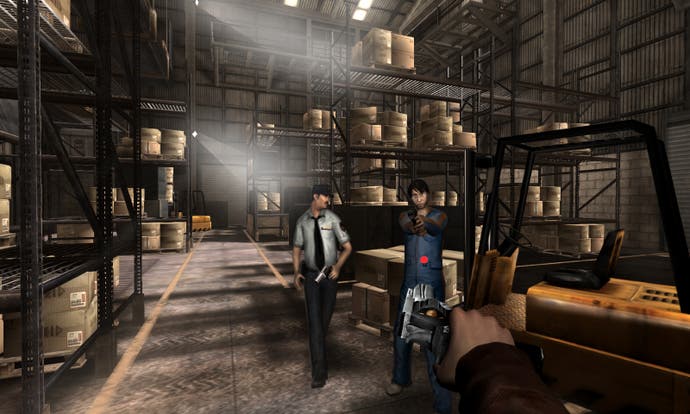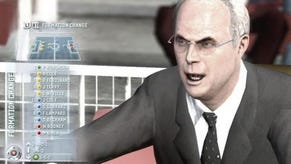Red Steel
Swords, but no sorcery.
Whilst working through the first few levels of Red Steel, I kept being reminded of GoldenEye, and I couldn't figure out why. It wasn't the weapons, it wasn't the excellent level design (unfortunately that's something Red Steel cannot boast), it wasn't similar environments or familiar set-pieces or anything else immediately obvious. Then, suddenly, I realised that it was because it looked like GoldenEye - these were the same blocky characters, fuzzy textures and juddering framerates as I was seeing in 1998 with my N64 running through a blurry old RF lead. Obviously it's not quite as bad as that, certainly not when you remember to switch the Wii into 480p mode, but Red Steel's sheer ugliness is immediately and continuously noticeable. It looks half-finished, like a work-in-progress, linear levels punctuated by story-board sequences of stills that try to pass themselves off as cut-scenes.
And it's a real shame, because Red Steel has its moments. The immediacy of the control and small selection of inspired settings (a geisha house, or a Japanese garden, or a twisted amusement park) sometimes combine to make this an exhilarating, explosive action experience. There is an undercurrent of chaos running through Red Steel, and when the screen explodes into action and enemies come running out from every corner and forklifts start spontaneously blowing up and you're on your feet, shooting wildly at the screen whilst trying to run backwards into cover, you want to love it, you really do. But Red Steel feels just as often dated and incomplete as it does thrilling, and though the controls sometimes do much to make a great experience out of a fairly average game, it's never quite as good as you want it to be.

Red Steel follows the story of a faceless, voiceless American named Scott as he tries to infiltrate the Tokyo Yakuza in order to rescue his fiancée, the daughter of an influential boss whose Los Angeles hotel is ransacked at the beginning of the game. It's not exactly the most believable portrayal of the mafiosa underground in the world, but it does provide a plausible excuse for setting the majority of the game in neon-lit urban Japan, which is occasionally its saving grace. The missions themselves are extremely linear, although you do sometimes get to choose which order to pursue them in. With two or three exceptions, they are straightforward - get from one end of the level to the other, shooting lots and lots of gangmen and pulling out a sword for the more challenging foes. It's not a story that you'll particularly care about, but the B-movie voice acting and plot twists fit the action well.
The shooting itself is excellent. As any lightgun game fan will know, controllers just cannot match the satisfaction of physically pointing and shooting at the screen, and a headshot is infinitely more rewarding when you've aimed it yourself. The auto-aim is perfectly balanced; it helps alleviate the occasional twitchiness of the controls without making success feel cheap. Holding A locks onto specific enemies and moving the remote closer to the screen zooms in on them, which quickly becomes second-nature. The focus system, which involves using the 'ancient ninja technique' of stopping time to disarm or outright kill multiple enemies at once, is a little superfluous, but it works well. Especially towards the end of the game, sparing lives by forcing a surrender is rewarded more often than mindless blasting.

The sword fights, unfortunately, don't live up to their promise. The controllers seem to have serious trouble picking up anything other than wild swinging gestures and there is no semblance of accuracy, which is troubling. Stupidly, blocking and striking at an opponent's sword arm are supposedly performed with exactly the same motion, and due to the general haphazardness of the whole thing the easiest way to defeat opponents is to perform the same powerful special moves over and over again or, worse, just swinging the controller aimlessly left and right and seeing what happens. At best, you're exchanging blows - there is nothing here that resembles skilful fencing. Sword fights are often infuriatingly placed right at the end of sections of levels, too, forcing you to replay from the last checkpoint and go through five minutes of tedious, repetitive shooting before dying again as soon as the swordsman appears. It's tempting just to shoot them as they approach, but of course, you can't do that - nor can you bring out the sword to finish off an enemy in the gunning sections.
Red Steel is an old-fashioned game at heart, linear and cheesy and a bit inflexible, but also responsive, explosive and often greatly entertaining. It has inspired moments and a substantial single-player venture, but the whole thing is undermined by the terrible presentation and the all-permeating impression that Red Steel isn't quite finished, from the story-board-sketch cut-scenes to the jerky animation and weird, basic, placeholder textures. It's never enough to stop Red Steel from being enjoyable, but in an age where we expect our FPSs to be beautiful as well as action-packed, it's just not up to standard. Red Steel is a prototype - it does just enough to show that a Wii first-person action game could be genuinely superb, but sadly, it never capitalises upon that potential itself.



